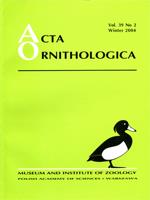The “costs of predation” hypothesis predicts that larger nests are more likely to be predated than smaller ones. However, nest size has not been found to be related to predation probability within any species. This study evaluated the “costs of predation” hypothesis in the Olivaceous Warbler during 2001–2003 in northwestern Bulgaria. Successful nests were significantly smaller and denser than those that were predated. Nest size decreased significantly during the course of the breeding season and increased with nest height. The relationship between nest size and the likelihood of predation was still significant even when the effects of laying date and nest height were controlled. Nest size was negatively related to fledging success even when only successful nests were considered. This finding is contrary to the prediction of the “sexual display” hypothesis, which states that nest size is positively related to fledging success, and suggests that nest size may signal phenotypic quality through the ability in this species to build a small but compact nest. It seems that both natural selection and sexual selection have led to the evolution of small nests in the Olivaceous Warbler. This is the most likely reason why the difference in nest-size between predated and non-predated nests was apparent, even in unmanipulated settings.
How to translate text using browser tools
1 December 2004
Smaller Eastern Olivaceous Warbler Hippolais pallida elaeica Nests Suffer Less Predation than Larger Ones
Anton Antonov
A. Antonov
,
D. Atanasova
2002. Nest-site selection in the Magpie Pica pica in a high-density urban population of Sofia (Bulgaria). Acta Ornithol. 37: 55–66. Google Scholar
D. E. Burhans
,
D. Dearborn
,
F. R. Thompson III
,
J. Faaborg
2002. Factors affecting predation at songbird nests in old fields. J. Wildl. Manage. 66: 240–249. Google Scholar
N. E. Collias
,
E. C. Collias
1984. Nest building and bird behaviour. Princeton Univ. Press. Google Scholar
S. Cramp
(ed.).
1992. Birds of Western Palearctic. Vol. VI. Warblers. Oxford Univ. Press. Google Scholar
G. P. Dementiev
,
N. A. Gladkov
1954. [Birds of the Soviet Union]. Vol. VI. Soviet Science, Moskva. Google Scholar
J. A. Fargallo
,
J. A. Davila
,
J. Potti
,
A. de Leon
,
V. Polo
2004. Nest size and hatchling sex ratio in chinstrap penguins. Polar Biol. 27: 339–343. Google Scholar
T. S. Filliater
,
R. Breitwisch
,
P. M. Nealen
1994. Predation on Northern Cardinal nests: does choice of site matter? Condor 96: 761–768. Google Scholar
H. Jakober
,
W. Stauber
1987. Habitatansprüche des Neuntöters (Lanius collurio) und Maβnahmen für seinen Schutz. Beih. Veröff. Naturschutz Landschaftspflege Bad. Württ. 48: 25–53. Google Scholar
M. D. Kern
1984. Racial differences in nests of White-crowned Sparrows. Condor 86: 455–466. Google Scholar
E. Lebedeva
1993. Olivaceous Warbler Hippolais pallida (Aves, Sylviidae) in the south of Dagestan: new data on biology of the species. Zool. Zhurnal 52: 98–111. Google Scholar
S. L. Lima
1987. Clutch size in birds: A predation perspective. Ecology 68: 1062–1070. Google Scholar
T. E. Martin
1992. Breeding productivity considerations: what are the appropriate habitat features for management? In:
J. M. Hagan
,
D. W. Johnson
(eds).
Ecology and Conservation of Neotropical Migrant Land Birds. Smithsonian Institution Press, Washington, DC, pp. 455–473. Google Scholar
T. E. Martin
1993a. Nest predation among vegetation layers and habitats: revising the dogmas. Am. Nat. 141: 897–913. Google Scholar
T. E. Martin
1993b. Nest predation and nest sites. New perspectives on old patterns. BioScience 43: 523–532. Google Scholar
A. P. Møller
1990. Nest predation selects for small nest size in the blackbird. Oikos 57: 237–240. Google Scholar
J. J. Palomino
,
M. Martin-Vivaldi
,
M. Soler
,
J. J. Soler
1998. Functional significance of nest-size variation in the Rufous Bush Robin Cercotrichas galactotes.
Ardea 86: 177–185. Google Scholar
S. P. Pashkovski
1965. [Olivaceous Warbler in the Belgorod Dnestrov (Ismail region)]. Ornithologiya 7: 287–289. Google Scholar
J. Pikula
1979. Die Lage und Zusammensetzung der Nester von Turdus philomelos in der CSSR. Zoologicke Listy 19: 163–196. Google Scholar
C. Sciurine
,
M. Kern
1980. The insulation in nests of selected North American songbirds. Auk 97: 816–824. Google Scholar
T. Slagsvold
1982. Clutch-size, nest-size and hatching asynchrony in birds: experiments with the fieldfare (Turdus pilaris). Ecology 63: 1389–1399. Google Scholar
T. Slagsvold
1984. Clutch size variation in birds in relation to nest predation: One the cost of reproduction. J. Anim. Ecol. 53: 945–953. Google Scholar
T. Slagsvold
1989. On the evolution of clutch size and nest size in passerine birds. Oecologia 79: 300–305. Google Scholar
D. W. Snow
1978. The nest as a factor determining clutch-size in tropical birds. J. Ornithol. 119: 227–230. Google Scholar
J. J. Soler
,
J. J. Cuervo
,
A. P. Møller
,
F. de Lope
1998a. Nest building is a sexually selected behaviour in the barn swallow. Anim. Behav. 56: 1435–1442. Google Scholar
J. J. Soler
,
Neve L. De
,
J. G Martínez
,
M. Soler
2001. Nest size affects clutch size and the start of incubation in magpies: an experimental study. Behav. Ecol. 12: 301–307. Google Scholar
J. J. Soler
,
A. P. Møller
,
M. Soler
1998b. Nest building, sexual selection and parental investment. Evolutionary Ecology 12: 427–441. Google Scholar
J. J. Soler
,
M. Soler
,
A. P. Møller
,
J. G. Martinez
1995. Does the Great Spotted Cuckoo choose Magpie hosts according to their parenting ability? Behav. Ecol. Sociobiol. 36: 201–206. Google Scholar
G. E. Walsberg
,
J. R. King
1978. The energetic consequences of incubation for two passerine species. Auk 95: 644–655. Google Scholar
A. Zahavi
1987. The theory of signal selection and some of its implications. In:
V. P. Delfino
(ed.).
Proceedings of the International Symposium on Biological Evolution. Adriatica Editrice, Bari. pp. 305–327. Google Scholar

Acta Ornithologica
Vol. 39 • No. 2
December 2004
Vol. 39 • No. 2
December 2004
breeding
fledgling success
Hippolais pallida
nest predation
nest size
Olivaceous Warbler




